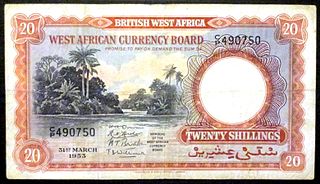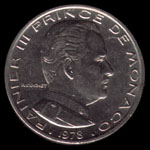The franc was the currency of Togo. Between 1924 and 1956, coins specifically for use in Togo were issued. Since 1945, Togo uses the West African CFA franc.
Between 1884 and 1914, the German mark was the currency of Togo as Germany was the colonial power. In 1914, Togo was occupied by British and French forces. Togo was split into two League of Nations mandate territories, with the western, British portion adopting the British West African pound and eventually becoming part of Ghana. In the eastern, French territory, the French franc was adopted, supplemented in 1924 by coins issued in the name of the Mandate Territory of Togo. These coins were issued intermittently until 1956 and circulated alongside the CFA franc from 1945. No circulating coins specific to Togo have been issued since 1956, although the 1957 coins of French West Africa also bore the name Togo.
In 1924, aluminium-bronze 50 centimes, 1 and 2 francs were introduced, with the franc denominations minted again in 1925 and the 50 centimes struck until 1926. In 1948, aluminium 1 and 2 francs coins were issued, followed by aluminium-bronze 5 francs in 1956.

The franc is any of several units of currency. The French franc was the currency of France until the euro was adopted in 1999. The Swiss franc is a major world currency today due to the prominence of Swiss financial institutions. The name is said to derive from the Latin inscription francorum rex used on early French coins and until the 18th century, or from the French franc, meaning "frank".

The franc, also commonly distinguished as the French franc (FF), was a currency of France. Between 1360 and 1641, it was the name of coins worth 1 livre tournois and it remained in common parlance as a term for this amount of money. It was reintroduced in 1795. After two centuries of inflation, it was revalued in 1960, with each new franc (NF) being worth 100 old francs. The NF designation was continued for a few years before the currency returned to being simply the franc; some mostly older French residents continued to reference and value items in terms of the old franc until the introduction of the euro in 2002. The French franc was a commonly held international reserve currency of reference in the 19th and 20th centuries.
The Congolese franc is the currency of the Democratic Republic of the Congo. It is subdivided into 100 centimes.

The franc, was the currency of Madagascar until January 1, 2005. It was subdivided into 100 centimes. In Malagasy the corresponding term for the franc is iraimbilanja, and five Malagasy francs is called ariary.

The Rwandan franc is the currency of Rwanda. It is subdivided into 100 centimes.

The Djiboutian franc is the currency of Djibouti. Its ISO 4217 currency code is DJF. Historically, it was subdivided into 100 centimes.
The franc is the official currency of Comoros. It is nominally subdivided into 100 centimes, although no centime denominations have ever been issued.

The British West African Pound was the currency of British West Africa, a group of British colonies, protectorates and mandate territories. It was equal to the pound sterling and was similarly subdivided into 20 shillings, each of 12 pence.
The franc was the currency of French Morocco from 1921. It became the currency of all Morocco in 1957 and circulated until 1974. It was divided into 100 centimes.

The franc was the currency of Cambodia between 1875 and 1885. It was equal to the French franc and was similarly subdivided into 100 centimes. It circulated alongside the piastre with 1 piastre = 5.37 francs. It replaced the tical and was replaced by the piastre. No paper money was issued.

The West African CFA franc is the currency of eight independent states in West Africa: Benin, Burkina Faso, Côte d'Ivoire, Guinea-Bissau, Mali, Niger, Senegal and Togo. These eight countries had a combined population of 105.7 million people in 2014, and a combined GDP of US$128.6 billion.

The franc was the currency of Tunisia between 1891 and 1958. It was divided into 100 centimes (صنتيم) and was equivalent to the French franc.

The franc was the official currency of the Principality of Monaco until 1995, when it changed to the French franc. The franc was subdivided into 100 centimes or 10 décimes. The Monégasque franc circulated alongside the French franc with the same value. Like the French franc, the Monégasque franc was revalued in 1960 at a rate of 100 old francs = 1 new franc. The official euro-to-franc exchange rate was MCF 6.55957 to EUR 1.
The franc was the currency of French Cameroun. It was subdivided into 100 centimes.
The franc was the currency of Réunion until 1999. Before 1975, Réunion had its own franc, distinct from that of France. After 1975, the French franc circulated. Réunion now uses the euro. The Réunion franc was subdivided into 100 centimes.
The franc is the currency of New Caledonia and Wallis and Futuna. It is subdivided into 100 centimes. Since 1945, it has been part of the CFP franc.
The franc is the currency of French Polynesia. It is subdivided into 100 centimes. Since 1945, it has been part of the CFP franc.
The Saint Pierre and Miquelon franc was the currency of Saint Pierre and Miquelon during a short time.
The franc was the currency of French Equatorial Africa. The French franc circulated, together with distinct banknotes from 1917 and coins from 1942. It was replaced by the CFA franc in 1945.

The franc was the currency of French West Africa. The French franc circulated, together with distinct banknotes from 1903 and coins from 1944. It was replaced by the CFA franc in 1945.